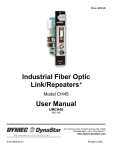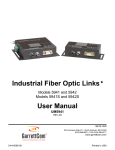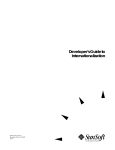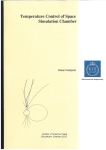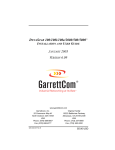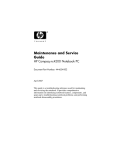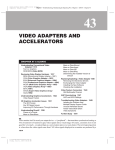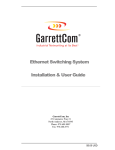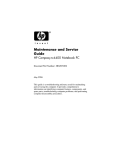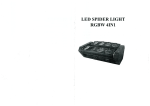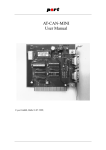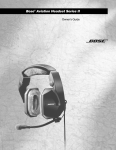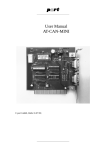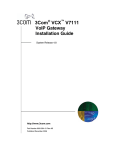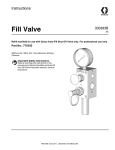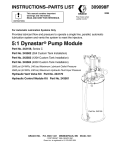Download Industrial Fiber Optic Link/Repeaters❺ User Manual
Transcript
Price: $25 US Industrial Fiber Optic Link/Repeaters \ Model CH43 User Manual UMCH43 REV AB 25 Commerce Way #1 • N. Andover, MA 01845 Phone (978) 688-8807 • FAX (978) 688-8771 www.garrettcom.com 3-44-0008-00 Printed in the USA Warnings, Cautions, and Notes as Used in this Publication WARNING Warning notices are used in this publication to emphasize that hazardous voltages, currents, or other conditions that could cause personal injury exist in this equipment or may be associated with its use. In situations where inattention could cause either injury or damage to equipment, a Warning notice is used. CAUTION Caution notices are used where equipment malfunction is possible if care is not taken. NOTE APPLICATION NOTE Notes and Application Notes call attention to information that is especially significant to understanding and operating the equipment. This document is based on information available at the time of its publication. While efforts have been made to be accurate, the information contained herein does not purport to cover all details or variations, nor to provide for every possible contingency in connection with installation, operation, or maintenance. DYMEC-DynaStar assumes no obligation of notice to holders of this document with respect to changes subsequently made. DYMEC-DynaStar makes no representation or warranty, expressed, implied, or statutory with respect to, and assumes no responsibility for the accuracy, completeness, sufficiency, or usefulness of the information contained herein. No warranties of merchantability or fitness for purpose shall apply. Permission is granted to make a reasonable number of copies of this document for the use within an organization which has purchased the equipment. Link/Repeater is used exclusively to describe DYMEC-DynaStar's unique family of Fiber Optic Data Links. \ Table of Contents Page 1. 2. 3. Introduction . . . . . . . . . . . . . . . . . . . . . . . . . . . . . . . . . . . . . 1-1 1.1 1.2 Definitions . . . . . . . . . . . . . . . . . . . . . . . . . . . . . . . . . Model CH43 Link/Repeater . . . . . . . . . . . . . . . . . . . . 1.2.1 9 Pin Data Port D-Connector . . . . . . . . . . . . . . . . . . . . . 1.2.2 DTE/DCE Jumper . . . . . . . . . . . . . . . . . . . . . . . . . . . 1.2.3 Data Coupling . . . . . . . . . . . . . . . . . . . . . . . . . . . 1.2.4 Mode Jumper . . . . . . . . . . . . . . . . . . . . . . . . . . . . . 1.2.5 Optical Ports . . . . . . . . . . . . . . . . . . . . . . . . . . . . . . 1.2.6 Diagnostic LEDs . . . . . . . . . . . . . . . . . . . . . . . . . . . 1.2.7 Power Connections . . . . . . . . . . . . . . . . . . . . . . . . . . 1.2.8 Peripheral Equipment . . . . . . . . . . . . . . . . . . . . . . . . 1-1 1-3 1-3 1-4 1-4 1-4 1-6 1-7 1-8 1-8 Configurations, Operation, and Installation . . . . . . . . . . . . . . . . . . . 2-1 2.1 2.2 Point-to-Point Configuration . . . . . . . . . . . . . . . . . . . . . . . Loop Operation - Master/Slave Configuration . . . . . . . . . . . . . . . . 2-1 2-5 Applications . . . . . . . . . . . . . . . . . . . . . . . . . . . . . . . . . . . 3-1 3.1 3.2 3-1 3-1 3-1 3-2 3-2 3-3 3-3 3-4 3-4 3-4 3-4 3-5 3.3 3.4 3.5 3.6 4. Testing and Troubleshooting . . . . . . . . . . . . . . . . . . . 4.1 4.2 5. 6. Data Rate . . . . . . . . . . . . . . . . . . . . . . . . . . . . . . . . . . Optical Budget . . . . . . . . . . . . . . . . . . . . . . . . . . . . . . . 3.2.1 Cable Attenuation Factors . . . . . . . . . . . . . . . . . . . . . . . 3.2.2 Extending the Distance . . . . . . . . . . . . . . . . . . . . . . . . . Number of Repeats . . . . . . . . . . . . . . . . . . . . . . . . . . . . 3.3.1 Effects of Data Rate . . . . . . . . . . . . . . . . . . . . . . . . . . 3.3.2 Pulse Width Distortion . . . . . . . . . . . . . . . . . . . . . . . . . 3.3.3 Temperature Effect . . . . . . . . . . . . . . . . . . . . . . . . . . . Powering the Link/Repeater . . . . . . . . . . . . . . . . . . . . . . . . . 3.4.1 Model CH43 . . . . . . . . . . . . . . . . . . . . . . . . . . . . . . . Type of Communication . . . . . . . . . . . . . . . . . . . . . . . . . . Selection of Fiber Optic Cable . . . . . . . . . . . . . . . . . . . . . . . . . . . . . 4-1 Testing . . . . . . . . . . . . . . . . . . . . . . . . . . . . . . . . Troubleshooting . . . . . . . . . . . . . . . . . . . . . . . . . . . . . 4-1 4-1 Specifications . . . . . . . . . . . . . . . . . . . . . . . . . . . . . . . . . . . . 5-1 5.1 5.2 5-1 5-2 Electrical and Optical Specifications . . . . . . . . . . . . . . . . . . . . Mechanical Dimensions of the CH43 . . . . . . . . . . . . . . . . . . . . . Ordering Information . . . . . . . . . . . . . . . . . . . . . . . . . . . . . . . . . . 6-1 Model CH43 RS 232 1 INTRODUCTION DYMEC-DynaStar Model CH43 is a data communication Link/Repeater Card, for use in the DYMECDynaStar 3900 Series Chassis, which allows the replacement of copper wire with fiber optic cable. Link/Repeaters simply convert electrical signals to light for transmission, then, when received, convert the light to electrical signals. This is done for RS-232 formats. Link/Repeaters are passive to software protocol. They are not addressable in communication protocols and do not provide any control logic capability supporting communication protocols. Link/Repeaters are designed with several features that allow easy installation and flexibility in configuring for various communication systems. One should read all of this manual to fully understand how to use the many features of the Link/Repeaters in an effective communication system. 1.1 DEFINITIONS The following terms are used in this manual: IED: An IED is any intelligent electrical device capable of RS-232 data communication, such as; a computer, RTU, PLC, "smart" meter, relay, etc. The IED must have resident software or firmware that manages the data communication logic, including protocol (formatting and timing), addressing capability (if required), control logic software "handshaking", and scheduling. Point-to-Point Configuration: Two Link/Repeaters connected directly to each other. Master/Slave Loop Configuration: More than two Link/Repeaters connected together where the FOC connects the T optical port of one device to the R optical port of the next unit in the loop. One IED is designated as the Master and controls all the communication and the other IEDs act as Slaves and respond only when specifically polled by the Master. Peer-to-Peer Loop Configuration: More than two Link/Repeaters connected together where the FOC connects the T optical port of one device to the R optical port of the next unit in the loop. Each IED has the capability of becoming loop Master as allowed by the controlling software. Echo: The return of the Master's transmission [Packets] back to the Master after traveling around an optical loop. Optical Bus Configuration: More than two Link/Repeaters connected together in a manner where the Master's transmission is heard by all IEDs and there is no returning echo of this transmission [Packet]. Optical Star Configuration: More than two Link/Repeaters connected together in a “hub and spoke” topology where the Master’s transmission is heard by all IEDs and only the Master hears the polled Slave’s response and there is no returning echo of the Masters transmissions [Packet]. Master: The Master is the IED which controls the loop in a Master/Slave loop. This IED is responsible for the control of the loop, the polling of the Slaves for information, and the prevention of data collisions. All loop communication is echoed back to and stops at the Master. The Master's Link/Repeater mode jumper is always in the "OFF" position. 1-1 Model CH43 RS 232 Slave: A Slave is an IED that is passive in a Master/Slave loop. A Slave's communication is under the control of the Master, and should be controlled to prevent data collision in the loop. All communication generated by the Master will be repeated through each Slave and back to the Master. A Slave's Link/Repeater mode jumper is always in the “ON” position. FOC: Fiber Optic Cable. Single-mode: Single-mode fibers generally have diameters of 5µm to 13µm. Because of this small core, only one axial path for light propagation is available through the fiber. The optics required to drive single-mode fiber have to be highly focused so that minimum dispersion occurs. Though requiring more expensive optic emitters, the benefit is that longer transmission distances (up to ~30 km) can be achieved. Multi-mode: Multi-mode fibers have core diameters of 50µm and larger. This larger core allows the light rays to be propagated along several different paths down the fiber. The different paths include an axial component as well as reflected components. Multi-mode units are economical and effective for transmission over distances up to 5 km. Repeat Mode Jumper: The mode jumper enables (ON) or disables (OFF) the repeater function of the Link/Repeater. DTE/DCE Jumper: Each Link/Repeater is provided with this jumper to easily adapt the device for either the DTE or DCE configuration of the equipment which it connects. Data Coupling Jumper: Each Link/Repeater is provided with this jumper to easily adapt the device for either DC or AC electrical Input data coupling. With AC data coupling the minimum input data rate is 1200 baud with DC data coupling there is no minimum input data rate but a signal stuck on the input will lock up a loop, bussed or star network. Simplex Communication: Transmit only or receive only communications. Half Duplex Communication: Sequential transmit and receive communications. Full Duplex Communication: Simultaneous transmit and receive communications. T: Transmit optical port. TE: Diagnostic LED that illuminates when the Link/Repeater is receiving an electrical transmit from its IED. TO: Diagnostic LED that illuminates when the Link/Repeater is transmitting a signal optically. R: Receive optical port. 1-2 Model CH43 RS 232 RE: Diagnostic LED that illuminates when the Link/Repeater is delivering a received optical signal electrically to the IED. RO: Diagnostic LED that illuminates when the Link/Repeater is receiving a signal optically. Optical Budget: The optical budget is expressed in dB and is the amount of light loss tolerated for reliable communication. The total distance between two devices that a signal can be transmitted is determined by subtracting all the losses of the circuit from the optical budget. Various factors in the optical circuit attenuate the light transmission and must be accounted for to assure a reliable optical circuit. Key factors include cable attenuation (expressed as dB per unit length), cable aging, and cable fittings (terminations, splitters, couplers, etc.). Non Return to Zero (NRZ): This type of encoding scheme does not require the voltage potential of each data bit to return to the zero potential. No clock or timing recovery is provided with this type of communication except in the start and stop bits usually found on each data word. Return to Zero (RZ): This type of encoding scheme requires the voltage potential of each data bit to return to the zero potential. This allows timing recovery with each bit instead of just the start and stop bits of the data word. Number of Repeats: The Number of Repeats is the number of Link/Repeaters that may be connected in a loop configuration. The sum of Slaves in a Master/Slave loop is the number of repeats for that type of loop. The number of Peers minus one is the number of repeats in a Peer-to-Peer loop. Asynchronous Communication: This type of communication does not transmit a separate clock signal with the data signal. Link/Repeaters only support asynchronous communication. A communication scheme where the clock needs to be transmitted (Synchronous Communication) is not supported unless the data and clock are transmitted together on the same pin. 1-3 Model CH43 RS 232 MODEL CH43 LINK/REPEATER Each Link/Repeater consists of the following elements shown in Figure 1. DCE/DTE Jum pers D CE D TE Diagnostic LED's DC AC OFF ON D ATA COU P L IN G D B 9 CON FIG U R A TION DB 9 Connector R E PE AT M OD E 1.2 ST Fiber Connectors Repeat Mode Jum per Data Coupling Jum pers FIGURE 1. Elements of the Link/Repeater 1.2.1 9 Pin Data Port D-connector The Link/Repeater connects directly to an IED's RS-232 communication port. The pin out configuration of the Link/Repeater is shown in Figure 2. If the IED's port is not a 9 pin Dconnector or if the IED's pin out configuration differs, an adapter is required. DCE MODE • • • • • • • • 2 3 1 4 5 6 7 8 DTE MODE Transmitted Data (Link Input) Received Data (Link Output) Internal Jumper Signal Common Data Set Ready (+5 Vdc Output) Internal Jumper • • • • • • • • 2 3 1 4 5 6 7 8 Received Data (Link Output) Transmitted Data (Link Input) Internal Jumper Signal Common Data Set Ready (+5 Vdc Output) FIGURE 2. Data Port Pin Assignments 1-4 Internal Jumper Model CH43 RS 232 1.2.2 DTE/DCE Jumper The DTE/DCE Jumper on the Link/Repeater changes the functions of pins 2 and 3 to accommodate the IED configuration as DTE or DCE. 1.2.3 DTE: Data Terminal Equipment. By RS-232 standards, equipment designed as DTE transmits data out of pin 2 on a 9 pin D-connector and receives data on pin 3. DCE: Data Communication Equipment. By RS-232 standards, equipment designed as DCE transmits data out of pin 3 on a 9 pin D-connector and receives data on pin 2. Mode Jumper The Mode jumper enables the repeater function in the “ON” position and disables it in the "OFF" position. 1.2.4 ON: The repeater function available in the Link/Repeater is enabled. This function converts the optical signal received on the R optical port to an electrical signal and delivers this signal to the appropriate pin of the 9 pin connector, it also, re-transmits the signal optically out the Link/Repeater's T optical port. OFF: The repeater function available in the Link/Repeater is disabled. The Link/Repeater converts the optical signal received on the R optical port to an electrical signal and delivers this signal to the appropriate pin of the 9 pin connector, and does not re-transmit the signal optically out the Link/Repeater's T optical port. Data Coupling Jumper The Data Coupling jumper selects the electrical input conditioning, the AC position selects capacitively coupled, the DC position is directly coupled. AC: AC coupling has a minimum incoming data requirement of 1200 baud due to the capacitive coupling. This option blocks DC electrical levels should the device connected fail and ‘stick in a high level’. DC: DC coupling allows DC logic levels to be transmitted over the fiber network, care must be taken to guarantee that when any device stops transmitting packets that the input level returns to a state that allows the T receptacle (emitter) to turn off. If it does not and the IED is part of a loop, bussed or star network, the first device to transmit blocks all other devices on the network from transmitting. R E P E A T M O D E D B 9 C O N F IG U R A T IO N D A T A C O U P L IN G D CE A C D T E D C FIGURE 3. Jumper Settings (Factory Default Settings) 1-5 O F F O N Model CH43 RS 232 Optical Ports D CE D TE There are two optical ports, T and R. The T optical port transmits data signals optically to the next Link/Repeater. The R port receives the optical data signal from another Link/Repeater's T optical port. Each port is fitted with an "ST" type receptacle for attaching the FOC. D B 9 CON FIG U R A TION 1.2.5 T Optical Port R Optical Port FIGURE4. Optical Ports IED T IED R COM 2 5 3 R E P E A T T M O D E O F F R COM 2 5 3 O N R E P E A T M O D E O F F O N Repeat Jum per OFF Repeat Jum per ON FIGURE 5. Data Signal Path 1-6 Model CH43 RS 232 1.2.6 Diagnostic LEDs Each Link/Repeater is equipped with four diagnostic LEDs. They represent the electrical transmit (TE), optical transmit (TO), electrical delivery (RE), and optical receive (RO) paths. These LEDs, when illuminated, show that the appropriate path is active. When the Link/Repeater is transmitting, both TE and TO LEDs will illuminate to show the transmit path active. When the Link/Repeater is receiving light signals, both RO and RE LEDs will illuminate. If the unit is in the repeat mode and receiving light, the RO, RE and TO LEDs will illuminate because the signal is being re-transmitted out the optical port, as well as, being delivered to the D-connector. LEDs only illuminate when the path is active; powering of the unit does not illuminate the LEDs unless their path is active. When data is present on the paths, the LEDs may "flicker"; this is normal. The diagnostic LEDs may be used for trouble shooting by observing that the illumination of the LEDs corresponds to activity in the unit. See Figure 5 for LED patterns and signal paths. FIGURE 6. Diagnostic LED positions on faceplate of CH43 2 3 2 3 2 REP REP OFF OFF 3 REP OFF Normal Transmission Normal Receive Repeat Mode Selected FIGURE 7. Diagnostic LED patterns and signal paths NOTE The LEDs only illuminate when there is signal traffic and are not illuminated during signal "quiet" times. The LEDs may "flicker". This is normal operation. 1.2.7 Power Connections Powering Model CH43 Model CH43 is powered through a blade connector when inserted in the DYMEC-DynaStar 3900 15 slot Chassis: Model CH43 has an internal DC/DC converter that isolates system and earth ground from signal ground on the DB9 Connector. Care must be taken, when cabling, not to short these together as the SWC capabilities will be compromised. 1-7 Model CH43 RS 232 1.2.8 Peripheral Equipment 1.2.8.1 IED An IED is any intelligent electrical device such as; a computer, RTU, PLC, "smart" meter, relay, etc., that has the ability to communicate data via RS-232. The IED should have a communication port for the connection of the Link/Repeater. If the IED's communication port connector does not accept the Link/Repeater to be plugged in directly, an adapter must be made to accommodate the connection. Care should be taken to assure that the correct signals are connected to each other. See Figure 2 for the Link/Repeater's pin signal assignments. Check your IED's equipment manual for its signal assignments. The IED must also have intelligent software to execute the data communication. This intelligence needs to logically manage the data and signal traffic, including any addressing, token passing, "handshaking", data formatting and scheduling. 1.2.8.2 Fiber Optic Cable (FOC) The selection of the fiber optic cable is important. High quality cable can assure the maximum performance of your Link/Repeater. Important factors to consider are the manufacturer's specification on attenuation per unit length, attenuation due to aging, diameter, and tensile strength. Choosing the best quality FOC for your installation is important. Model CH43 Link/Repeater optical ports are designed for ST type terminations and are compatible with multi-mode FOC ranging from 50 µm to 200 µm. NOTE DYMEC-DynaStar can supply multi-mode glass FOC in either Simplex, Duplex, or Breakout construction, cut to length, terminated, polished and tested. The specification for all DYMEC-DynaStar supplied cables are as follows: Fiber Diameter: 62.5/125µm Tensile Strength: 100 kpsi Loss: 3 dB per kilometer Aging Loss: less than 3 dB 1-8 Models CH43 and PC43 RS-232 2 CONFIGURATIONS, OPERATION, AND INSTALLATION Model CH43 Link/Repeater can be connected in a Point-to-Point configuration, in a Master/Slave Loop or an optical bus depending on the needs of the overall communication system. This model is designed to accept electrical inputs per RS-232 standards. RS-232 data communication signals are always on pins 2 or 3 (transmit or receive pin assignment is based upon the setting of the DTE/DCE jumper) of the Link/Repeater's 9 pin D-connector. All signal voltage levels on the 9 pin D-connector are referenced to pin 5 of the D-connector. It is also possible to optically connect Link/Repeaters together which are connected to IEDs with different electrical formats. It is possible to optically interconnect Models CH45, 5845 and 5846 (operating EIA 422/485) to DYMEC-DynaStar Model CH43 which is connected to IEDs operating with RS-232 formats. APPLICATION NOTE DYMEC-DynaStar Models CH43, CH45, 5845 and 5846 can optically communicate to each other, eliminating the need for format translation interfaces, provided all connected devices are operating at the same data rate. 2.1 POINT-TO-POINT CONFIGURATION For Point-to-Point operation, two Link/Repeaters are optically connected to each other. This configuration permits full duplex communication (simultaneous transmitting and receiving), half duplex communication (sequential transmitting and receiving), and simplex (transmitting or receiving only). Master T COM 2 5 Slave R T 3 COM 3 DT E 5 DCE R 2 DT E DCE REP REP O FF O FF FIGURE 8. Point-to-Point Configuration APPLICATION NOTE 2-1 Models CH43 and PC43 RS-232 In Point-to-Point operation, the communication logic (control software) of the IEDs must manage: 1) 2) 3) the transmission of data signals. the receipt of data signals. any "handshaking" required must be accomplished through software. 2.1.1 Installation 1. Set the DTE/DCE Jumper to the appropriate position for each Link/Repeater and its respective IED. 2. Set the Mode Jumper on both of the units to the "OFF" position. 3. Set the Data Coupling Jumpers for the appropriate position based on the data rate used in the communication network 4. Insert the CH43 into an open slot in the 3900 Chassis and then energize the power source to the 3900 Chassis (See the Installation Sheet for the 3900 Chassis for powering Instructions). The Link/Repeater Card is now powered. 5. Connect the Link/Repeater to the IED's RS-232 communication port (including any adapter that may be needed). 6. Connect the Fiber Optic Cables (T of one device to R of the second device). 7. The units are now installed and operating. 8. Verify operation using the diagnostic LEDs. (See Figure 5). NOTE The LEDs only illuminate when there is signal traffic and are not illuminated during signal "quiet" times. The LEDs may "flicker". This is normal operation. APPLICATION NOTE The Point-to-Point concept can be used to create an "optical bus" network. This can be useful for those situations where the software in the Master has not been written in such a way that it can handle the return of the transmitted echo that occurs in loop networks. Figure 8 shows the connection scheme for an RS-232 optical bus. Note that all Slaves hear the Master's transmission but only the Master hears the response from the addressed Slave. The Master must always be the first IED in the network. 2-2 Models CH43 and PC43 RS-232 RS 232 M aster / Slave M aster COM T 2 5 Typical Slave T COM R R 3 2 R EP 5 3 2 Last Slave T COM R 5 3 R EP OFF 2 5 3 OFF R EP R EP OFF OFF FIGURE 9. RS-232 Bus Configuration APPLICATION NOTE Another variation of the point-to-point concept, is the Optical Star network. This topology may be created using the DYMEC-DynaStar Optical Star OS5 or OS9. This topology creates a “Hub and Spoke” configuration which can be useful in solving a network configuration based upon the physical positioning of the nodes. The DYMEC-DynaStar Optical Stars can also be used to create a multi-drop Master / Slave Optical Star network. The Models CH43 and PC43 are optically compatible with the OS5 and OS9 Master and Slave ports. Figure 10 shows a typical connection of an Optical Star network. The master IED must always be connected to the Master port of the Optical Star. The slave IED’s must always be connected to the Slave ports of the Optical Star. Variations of this configuration are as follows: The optical star may be the last node of an optical bus configuration. One may create an Optical Bus configuration starting with the Master IED to a series of Slave IEDs and then connect the fiber network to the Master port of the OS5 or OS9 to continue the network in a “Hub and Spoke” topology. A Master IED may be connected to the master port of an OS5 or OS9 and then an Optical Bus network may be created from any Slave Port of the Optical Star. The Optical Stars maybe “cascaded”. Cascading means optically connecting a Slave Port of one Optical Star to the Master Port of the next Optical Star. IEDs of different electrical formats (i.e., RS-232, EIA 422, EIA 485 2-wire or EIA 485 4-wire) may also be interconnected optically in the Star Configuration. Models 5845 and Models 5846 are optically compatible with the CH43 and are used to serve the EIA 422 and EIA 485 devices. 2-3 Models CH43 and PC43 RS-232 NOTE It is not recommended that a “loop network” be connected to an Optical Stars Slave Port Master IED T R D ym ec M O D EL O S5 FIBER O PT IC ST AR Slave IED T Slave IED R T Slave IED R T R D ym ec M O DEL O S5 FIB ER O PT IC ST AR Slave IED T Slave IED R T Slave IED R T FIGURE 10. Optical Star Configuration (OS5 cascaded to an OS5) 2-4 Slave IED R T R Models CH43 and PC43 RS-232 2.2 LOOP OPERATION - MASTER/SLAVE CONFIGURATION NOTE Before constructing a loop network, be sure that the software protocol of the Master is capable of managing the receipt of its own echoed transmission. If it cannot, then use Point-to-Point configurations only between devices in an "optical bus" network approach. This configuration supports a system which requires more than two IEDs to be communicating. In a Master/Slave loop system, one IED acts as a Master at all times and addresses or "polls" each of the other connected IEDs individually. Each Slave receives the same transmission from the Master IED but only responds when it recognizes its address in the polling message. M aster T R COM 2 5 3 R EP OFF 3 T 5 COM Slave R EP R EP R EP OFF OFF OFF 2 R 3 T 5 COM Slave 2 3 R T 5 COM 2 R Slave FIGURE 11. Master/Slave Loop Configuration The Master must have its Mode jumper in the "OFF" position. When it transmits a request out its T optical port, it will receive the echo of its request at its R optical port. This request has gone around the loop, and has been repeated by each Slave in the loop. However, the Master does not repeat (retransmit) any of these received signals optically back around the loop, because its Mode jumper is in the "OFF" position. 2-5 Models CH43 and PC43 RS-232 NOTE The communication logic and control software of the Master IED must be able to manage the receipt of its echoed request. The receipt of the echo can be used in conjunction with a watchdog timer to continuously verify loop integrity. When addressed, the Slave will transmit an appropriate response. Each Link/Repeater connected to a Slave IED must have its mode jumper set in the “ON” position. In this mode, all signals received on a Slave's R optical port are delivered to the IED’s communication port and at the same time repeated out the T optical port to the next device in the loop. If an IED determines that this request requires a response, then the Link/Repeater transmits the IED’s response out the T optical port. The response is repeated at each Slave device, until it arrives at the Master. When an IED is a Slave, it should not attempt to initiate a transmission while it is receiving a signal. Since signals being received are also being repeated at the same time, any attempts to transmit its response while still receiving can corrupt both transmissions due to a data collision. CAUTION If a Slave IED attempts to transmit while receiving a message, a data collision will occur. In Master/Slave Loop Operation, half duplex communication (sequential transmit and receive functions) is available. Only the Master can communicate full duplex (simultaneous transmit and receive) in a Master/Slave loop. APPLICATION NOTE In a Master/Slave Loop Operation, the communication logic (control software) and the Master IED must manage: 1) The transmission to Slaves (including addressing). 2) The receipt of the echo of its transmissions. 3) The receipt of the Slave's response to its transmission. 4) The control of the Slaves to prevent the initiation of a transmission while receiving a signal. 2.2.1 Installation 1. Set the DTE/DCE Jumper to the appropriate position for each Link/Repeater and its respective IED. 2. Set the Mode Jumper on both of the units to the "OFF" position. 3. Set the Data Coupling Jumpers for the appropriate position based on the data rate used in the communication network 4. Insert the CH43 into an open slot in the 3900 Chassis and then energize the power source to the 3900 Chassis (See the Installation Sheet for the 3900 Chassis for powering Instructions). The Link/Repeater Card is now powered. 5. Connect the Link/Repeater to the IED's RS-232 communication port (including any adapter that may be needed). 6. Connect the Fiber Optic Cables (T of one device to R of the second device). 2-6 Models CH43 and PC43 RS-232 7. The units are now installed and operating. 8. Verify operation using the diagnostic LEDs. (See Figure 5). NOTE The LEDs only illuminate when there is signal traffic and are not illuminated during signal "quiet" times. The LEDs may "flicker". This is normal operation. 2-7 Models CH43 and PC43 RS-232 3 APPLICATIONS When planning a system using Model CH43 and Model PC43 Link/Repeaters, the following considerations should be reviewed: • • • • • • 3.1 Data Rate Optical Budget and the distance between connected units Number of units in a loop configuration Powering the Link/Repeaters Type of communication including format Selection of Fiber Optic Cable (FOC) DATA RATE Model CH43 and Model PC43 Link/Repeaters automatically support all data rates from 1000 bits per second to 250 Kilobits per second. No internal selection nor setting is required. However, it is necessary that all connected IEDs be set at the same data rate. 3.2 OPTICAL BUDGET The optical budget is a ratio of the receiver sensitivity to launched optical power, i.e. amount of light loss available from the transmitter to the receiver. It is calculated on a log scale so that a 3 dB loss is equal to half of the original power, 10 dB is one tenth of the original power, 20 dB is one hundredth, etc. Many different elements in the optical circuit can induce losses to the power of the signal. This attenuation must be taken into account when determining the distance that the signal can be transmitted. The major factor is the attenuation of the fiber optic cable. Cable attenuation is expressed as "X" dB per kilometer. Other factors of attenuation include FOC fittings (terminations, splitters, etc.) FOC diameter and FOC aging. Optical budget is the result of the expression: Launch Power [µw] Each Model CH43 or PC43 Link/Repeater has a typical optical budget of 19.5 dB. 3.2.1 Cable Attenuation Factors The following cable factors must be applied as corrections to the optical budget. 3.2.1.1 Diameter Multi-mode: FOC of different diameters will vary the available optical budget of a system due to different FOC core diameters. The typical 19.5 dB optical budget is applicable to 62.5 µm diameter FOC. Table 1 shows the correction factors to use on the available optical budget for different diameter cable. FOC Diameter Table 1 Factor 50µm 100µm 200µm -3 dB +4 dB +7 dB 3-1 Models CH43 and PC43 RS-232 3.2.1.2 Fittings Adding additional splices, feed throughs, or patches to the FOC will add losses to the available optical budget. When using multi-mode Fiber Optic Cable terminated and supplied by DYMECDynaStar, optical connector losses can be ignored because the cable is tested after the terminations are added. If you are using fittings not supplied by DYMEC-DynaStar, you can get the optical budget loss information from their manufacturer(s). 3.2.1.3 Aging As FOC ages, tiny cracks will form in the glass core of the fiber. These will cause the attenuation of the cable to increase. The optical emitters age over time causing a reduction in their optical launch power. DYMEC-DynaStar suggests that a buffer be applied to the optical budget to assure proper operation of the unit over a 20-year life. A 2.5 dB to 3 dB loss factor is suggested to compensate for system aging over 20 years. EXAMPLE: FOC is 62.5/125 µm multi-mode (DYMEC-DynaStar supplied) 100 kpsi rated 3 dB/km and 3 dB for aging No other attenuating items in the circuit initial: less: less: equals: divided by: equals: 19.5 dB Optical Budget 3 dB aging 0 dB for other circuit attenuation fittings 16.5 dB 3 dB/km 5.5 km maximum distance of FOC between transmitter and receiver NOTE FOC extends communication beyond normal RS-232 Standards limits. The distance allowable between Link/Repeaters must be calculated using the factors listed above. 3.2.2 Extending the Distance Should the distance between two devices exceed that calculated above, it is possible to insert a Model CH43 or Model PC43 Link/Repeater to function as a stand alone repeater, not connected to an IED. Two Link/Repeaters would be necessary, one for each fiber path. When installed as a repeater only, the 9 pin D-connector of either Model CH43 or Model PC43 should be installed with a terminator that covers the pins and connects the transmit pin (2 or 3 depending on the DTE/DCE jumper position) to the signal common pin 7 and also connects the signal common pin 7 to the chassis ground pin 1. 3.3 NUMBER OF REPEATS In a loop configuration, the number of units that can be used as repeaters must be determined. A repeater is any unit that uses the repeat function of the Link/Repeater. All Slaves in a Master/Slave loop are considered repeaters. Three factors must be considered in calculating the maximum number of repeaters possible in a loop: the data rate (bits per second), the minimum required width of the original pulse echoed back to the Master, and the peak operating temperature. 3-2 Models CH43 and PC43 RS-232 Numbe r of Re pe ats in a Loop Configuration* 1000 Repeats 100 10 1 1 10 100 1000 D ata R ates (kbps) FIGURE 12. Number of Repeats 3.3.1 Effects of Data Rate The number of repeaters is an inverse linear function to the data rate (more repeats at lower data rates). The data rate, or bits per second rate, determines what the original pulse width of each bit will be. The higher the data rate, the smaller the pulse width of each bit. As the signal passes through a repeater, the distortion effect (which is a fixed amount) on the data signal is greater (as a percentage of the pulse width) at higher data rates due to the narrower pulse widths than at lower data rates. 3.3.2 Pulse Width Distortion As the data signal is passed from repeater to repeater, there is a small change to the pulse width defined as pulse width distortion. The amount of change that is tolerable corresponds to the percentage of original pulse width required by a particular communication system design. Typically, a communication system requires that the data word, or bit stream, which each Slave IED receives, match the signal originally generated by the Master, within some tolerance of pulse width distortion. High tolerance systems allow more pulse width distortion, therefore, more repeats are tolerated. Conversely, low tolerance systems allow fewer repeats in the loop. Figure 10 shows the maximum number of repeats possible if 70% of the original pulse width is required by any IED in the loop. The acceptable percentage of the original pulse width is due to the requirements of the IEDs. If more of the original pulse width is necessary or less is allowable, then the number found in Figure 10 can be modified. Table 2 shows the factors to be used to correct the number of repeats found in Figure 10 for such cases. 3-3 Models CH43 and PC43 RS-232 Table 2 % of Original Pulse Multiply Factor 80% 60% 50% 3.3.3 .67 1.33 1.67 Temperature Effect At peak operating temperature above 65°C, the maximum number of repeats should be derated by 20%. At higher temperatures, the distortion caused by each repeat increases, causing the maximum number of possible repeaters to go down. EXAMPLE: Peak temperature of the system will be 70°C Running at 9600 bps 60% of original pulse width possible initial: less: times: equals: 3.4 100 repeats (from Figure 10) 20% de-rate for 70°C 1.33 for 60% pulse width 100 x 0.8 x 1.33 = 106 repeats POWERING THE LINK/REPEATER Model CH43 is designed to be powered through the connector on the backplane of the DYMEC-DynaStar 3900 15 slot Chassis. 3.5 TYPE OF COMMUNICATION Model CH43 and Model PC43 Link/Repeaters support the following types of asynchronous communications: Simplex - Transmission only or receive only Half Duplex - Sequential transmit and receive Full Duplex - Simultaneous transmit and receive Simplex Half Duplex Full Duplex Point-to-Point: (Mode jumper "OFF") X X X Master/Save Loop: Master (Mode jumper "OFF") X X X Master/Slave Loop Slave (Mode jumper “ON”) X X 3-4 Models CH43 and PC43 RS-232 3.6 SELECTION OF FIBER OPTIC CABLE (FOC) Fiber optical cable is available in several formats: simplex, duplex, and breakout. FOC is also available in various diameters and tensile strengths. Tensile strength is important for longer life expectancy. Simplex FOC is desirable for loop operations. It has one optical conductor and can be connected from the transmitter of one Link/Repeater to the receiver of the next Link/Repeater in the loop. Duplex FOC has two optical conductors and is a convenient form when connecting two units Point-toPoint. Breakout cable is a duplex FOC that has extra strength members added and is suitable for burial and pulling in conduit. Breakout cable may be ordered with multiple pairs of fiber. For extreme conditions, it is also available with an armor jacket. Tensile strength is important for longer life expectancy. The following are the specifications of multi-mode FOC offered by DYMEC-DynaStar and is the recommended minimum standard for optimum performance. Fiber Count Fiber Material Attenuation Diameter Weight Tensile load - Short Term Tensile load - Long Term Minimum Bend Radius - With Load Minimum Bend Radius - No Load Crush Resistance Impact Resistance Flex Resistance Operating Temperature Storage Temperature [dB/km] [mm] [kg/km] [N] [N] [cm] [cm] [N/cm] [Cycles] [Cycles] o [ C] o [ C] Simplex Duplex Breakout 1 Glass 3 3.0 8.0 500 300 5 3 750 1000 7500 o o -40 to +85 o o -55 to +85 2 Glass 3 3.0 x 6.5 16.0 1000 500 5 3 750 1000 7500 o o -40 to +85 o o -55 to +85 2 Glass 3 7.0 50 1200 500 14 7 2200 2500 2000 o o -40 to +85 o o -55 to +85 METRIC-TO-ENGLISH UNIT CONVERSIONS MULTIPLY BY Millimeters Centimeters Meters Kilometers Kilometers → → → → → Inches Inches Feet Feet Miles 0.03937 0.3937 3.2808 3280.8 0.62137 MULTIPLY BY Kilograms Kg/Km Newtons N/Cm 3-5 → → → → Pounds Pounds/1,000 Ft Pounds Pounds/inch 2.2046 0.67197 0.22481 0.57101 Models CH43 and PC43 RS-232 4 4.1 TESTING AND TROUBLESHOOTING TESTING Models CH43 and PC43 lend themselves to easy installation and testing. Testing the units requires transmitting and receiving data while observing that the diagnostic LEDs are illuminating in the proper sequence. To test whether a unit is transmitting and receiving correctly, insert a short fiber jumper between its T and R optical ports, transmit a signal and note that all four diagnostic LEDs should illuminate during communication (refer to Figure 5). To test the units in a loop configuration, two Link/Repeaters are required. Connect short jumper fibers from the T optical port of one Link/Repeater to the R optical port of the other. Set the Mode jumper for one of the units to REP and the other to OFF. The unit with the Mode jumper in the OFF position is the Master. Using the Master, transmit and receive through the other unit in the repeat mode. Observe that the diagnostic LEDs illuminate during communication (refer to Figure 5). When a Link/Repeater is not connected to an IED and is in the "repeat" mode, Transmit (pin 2 or pin 3 depending on the position of the DCE/DTE jumper) and Chassis Ground (pin 1) should be connected to Signal Common (pin 7). This will prevent any spurious noise from being induced into the fiber optic loop circuit while servicing an IED. 4.2 TROUBLESHOOTING If the unit does not work properly, use the following check list: • Is the unit properly powered? • Verify the unit is receiving the correct power. • Check that the diagnostic LEDs are responding to the optical and electrical activity. • Is the unit mated properly to the IED? If an adapter is used, check that pin assignments are connected correctly. • Are the fiber cables connected properly? T to R; not R to R nor T to T. • Is the DTE/DCE jumper and the Repeat jumper set to the proper positions for the application? • Determine that the IED's originating signal is within standards. NOTE If the Link/Repeater is not connected directly to an IED, determine that the electrical signal received by the Link/Repeater is not corrupt. The Link/Repeater only repeats the signal it is given, it does not re-clock or re-generate the signal. • Review the IED's software and protocols. Does the IED have physical "handshaking" requirements and have the appropriate settings on the IED been made to compensate for these requirements? • Consult factory. 4-1 Models CH43 and PC43 RS-232 NOTE The LEDs only illuminate when there is signal traffic and are not illuminated during signal "quiet" times. The LEDs may "flicker". This is normal operation. NOTE Link/Repeaters contain no serviceable parts. Opening the unit will void the warranty. 4-2 5 5.1 SPECIFICATIONS Electrical and Optical Specifications (All Specifications over entire Operating Temperature Range) Models CH43 & PC43 LINK: I/O Data Format EIA RS-232C; CCITT v.24 Configuration DTE/DCE, jumper able Link/Repeater, jumper able Connector 9 pin D-type, female Data Rate DC to 250k bps Data Transmission Bit Error Rate Asynchronous, simplex or full duplex up to 5000 m (62.5/125µm cable @ 3 dB/km) 10E-9 max. Power Required + 5 Vdc, 500 mA max. Operating Temperature -40°C to +85°C Storage Temperature -45°C to +85°C Point-to-Point Latency Delay 4 µS max. Repeat Latency Delay < 400nS per Repeat Transmission Distance ELECTRICAL INPUT: Input Impedance >3000 Ohms Input Voltage ± 30 V max. ELECTRICAL OUTPUT: Output Impedance >300 Ohms Driver Output ± 5 V min. into 3000 Ohms OPTICAL INFORMATION: Optical Budget Typical Wavelength 19.5 dB (62.5/125 µm cable) 850nm Connector Type ST Fiber Type Multi-mode (50 - 200µm) All Specifications are subject to change without notice. 5-1 Mechanical Dimensions of the CH43 5.10 (12.95) 4.81 (12.21) R T CH43 ø.104 2X ALTERNATE MATING CONNECTOR: MOLEX P/N 8981-04M 5.2 LED IND. DB-9FEMALE CONNECTOR 0.55 (1.39) .99 0.41 "ST" (1.04) (2.51) OPTICS .06 (0.15) 5.0 (12.70) 0.60 (1.52) 1.04 0.4 (2.64) 0.5 (1.0) (1.27) 1.54 (3.91) 2.60 (6.60) 3.94 (10.00) DIMENSIONS ARE IN INCHES (CENTIMETERS) 5-2 6. ORDERING INFORMATION: LINK/REPEATERS Model CH43HRT PC43HRT 5843HRT 5844HRT-H 5844HRT-L CH45HRT 5845HRT 5846HRT-H 5846HRT-L 5843SHRT 5844SHRT-H 5844SHRT-L 5845SHRT 5846SHRT-H 5846SHRT-L EIA Std RS-232/TTL RS-232/TTL RS-232/TTL RS-232/TTL RS-232/TTL EIA 422/485 EIA 422/485 EIA 422/485 EIA 422/485 RS-232/TTL RS-232/TTL RS-232/TTL EIA 422/485 EIA 422/485 EIA 422/485 Part Number Fiber Type Multi-Mode Multi-Mode Multi-Mode Multi-Mode Multi-Mode Multi-Mode Multi-Mode Multi-Mode Multi-Mode Single-Mode Single-Mode Single-Mode Single-Mode Single-Mode Single-Mode Input Power Rating +5 Vdc +5 Vdc 9 - 15 Vdc 90-250 Vdc/ 90-250 Vac 24-48 Vdc +5 Vdc 9 - 15 Vdc 90-250 Vdc/ 90-250 Vac 24-48 Vdc 9 - 15 Vdc 90-250 Vdc/ 90-250 Vac 24-48 Vdc 9 - 15 Vdc 90-250 Vdc/ 90-250 Vac 24-48 Vdc ACCESSORIES Model 4310S Description AC to 12 Vdc Power adapter for Models 5843HRT, 5843SHRT, 5845HRT, 3340HRT, 3344HRT and 5845SHRT Bulletin UMCH43 User Manual for Models CH43, and PC43 Bulletin UM5845 User Manual for Models 5845, 5845S, 5846 and 5846S Bulletin UMCH45 User Manual for Models CH45, and PC45 Bulletin UM5843 User Manual for Models 5843, 5843S, 5844 and 5844S 5753A-XXXX Simplex Multi-Mode Fiber Optic Cable (62.5/125 µm), 100 KPSI. Suitable for use in cable troughs, conduit, and outdoor applications. 5754A-XXXX Duplex Multi-Mode Fiber Optic Cable (62.5/125 µm), 100 KPSI. Suitable for use in cable troughs, conduit, and outdoor applications. 5756A-XXXX Breakout Duplex Multi-Mode Fiber Optic Cable (62.5/125 µm), 100 KPSI. Suitable for use in cable troughs, conduit, and outdoor applications and direct burial, underground burial, lashed and building riser. Terminations Cable cut to length, Terminated with ST Type Multi-Mode Fiber Optic Connector and Complete Assembly Tested ACC-LCS Mounting Bracket ACC-CBL1 DB9 Male/ Tinned Lead Pigtail Cable XXXX = the length of the fiber optic cable in Meters (note: order only in full meters and not a fraction thereof) 1 Meter = 3.281 Feet 25 Commerce Way #1, N.Andover, MA 01845 (978) 688-8807 • FAX (978) 688-8771 www.DYMEC-DynaStar.com 6-1 READER'S COMMENTS We invite your comments and welcome suggestions to make this manual more useful. Bulletin # Rev # Today's Date GENERAL COMMENTS: Improve Acceptable Good Excellent Contents Organization Accuracy Clarity Completeness Example/Illustrations Referencing/Indexing Readability DETAILED COMMENTS: (Please be specific; i.e.: correct, expand, etc. ) Page No. Comments Other suggestions for improving this document: Compared to other manufacturers of a similar product, how would you rate this document? Superior Comparable Inferior Don't Know Comments: Comments concerning your specific application: Name: Title: Company: Address: City/State/Zip: Telephone/FAX: Please FAX or mail this sheet to the address listed below. Attn: Document Supervisor 25 Commerce Way #1, N.Andover, MA 01845 (978) 688-8807 • FAX (978) 688-8771 www.DYMEC-DynaStar.com





























